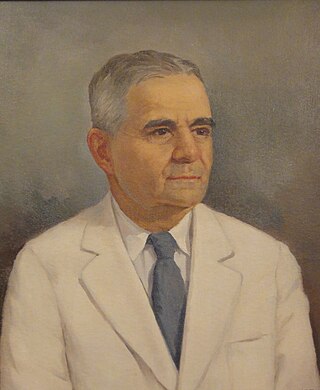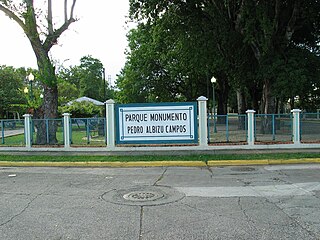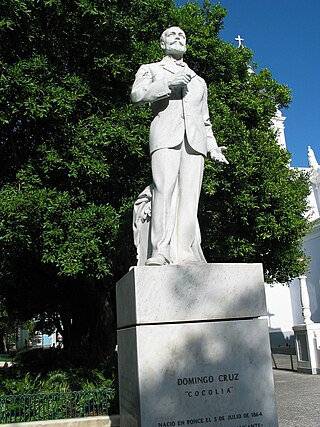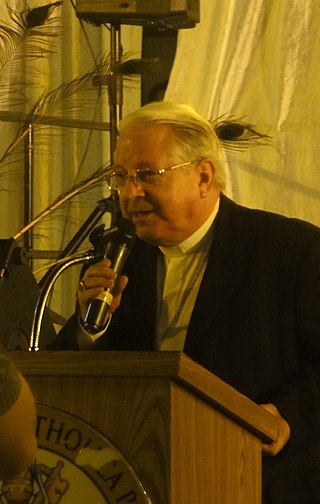
Rafael Cordero Santiago, better known as "Churumba", was the Mayor of Ponce, Puerto Rico, from 1989 to 2004. Many considered him as a synonym of Ponce, being baptized as "El León Mayor", an allusion to the city's official symbol, the lion. Mayor Cordero was a firm believer in the government decentralization process.

The following is an alphabetical list of articles related to the Commonwealth of Puerto Rico.

Plaza Las Delicias is the main plaza in the city of Ponce, Puerto Rico. The square is notable for its fountains and for the various monuments it contains. The historic Parque de Bombas and Ponce Cathedral buildings are located within the plaza, which actually consists of two squares: Plaza Muñoz Rivera on the north end, and Plaza Degetau on the southern end. The square is the center of the Ponce Historic Zone, and it is flanked by the historic Ponce City Hall to the south, the early 19th-century Teatro Fox Delicias to the north, the NRHP-listed Banco Crédito y Ahorro Ponceño and Banco de Ponce buildings to the east, and the Armstrong-Poventud Residence to the west. The square dates back to the early Spanish settlement in Ponce of 1670. It is the main tourist attraction of the city, receiving about a quarter of a million visitors per year.
Marta Romero was a Puerto Rican actress and singer, and one of the pioneers in Puerto Rican television.

Andrés Grillasca Salas was a Puerto Rican farmer from Adjuntas, Puerto Rico, and Mayor of Ponce, Puerto Rico, from 2 January 1941 to 9 May 1956. Until the 1990s administration of Rafael Cordero Santiago, Grillasca Salas had the distinction of being the longest-serving mayor of the city. He was known to always dress in white clothes.

The Parque Pedro Albizu Campos is a passive recreational park in the city of Ponce, Puerto Rico. It was dedicated on 12 September 1991, to the memory of Puerto Rican Nationalist leader Pedro Albizu Campos by the Government of the Autonomous Municipality of Ponce. Dr. Pedro Albizu Campos was born in Ponce on 12 September 1891. He was raised in Ponce and lived most of his life there as well.
Francisco Luis Porrata-Doría was a Puerto Rican architect from Ponce, Puerto Rico. Porrata-Doría was a pioneer in the development of the local modern architecture and one of the architects responsible for what has been called "Ponce Monumental Architecture", of which the Banco Crédito is a good example.

Plaza Degetau, formally Plaza Federico Degetau, is the larger of two plazas at Plaza Las Delicias, the main city square in the city of Ponce, Puerto Rico. The other plaza is named Plaza Muñoz Rivera and is located north of Plaza Degetau. The square is notable for its fountains and for the various monuments it contains. The historic Parque de Bombas and Ponce Cathedral buildings are located bordering the north side of this plaza. The square is the center of the Ponce Historic Zone, and it is flanked by the historic Ponce City Hall to the south, the cathedral and historic firehouse to the north, the NRHP-listed Banco Crédito y Ahorro Ponceño and Banco de Ponce buildings to the east, and the Armstrong-Poventud Residence to the west. The square dates back to the early Spanish settlement in Ponce of 1670. It is the main tourist attraction of the city, receiving about a quarter of a million visitors per year.

The Banco Crédito y Ahorro Ponceño building, a historic building in Ponce, Puerto Rico, was the first and main office of the historic Banco Crédito y Ahorro Ponceño, and represents one of the last examples of the once popular turn-of-the-century eclectic architecture. The building was listed on the U.S. National Register of Historic Places on June 25, 1987. It was built in 1924. The building was owned by Banco Crédito y Ahorro Ponceño which was one of the largest banking companies in the country of Puerto Rico during most of the twentieth century.

Domingo Cruz, a.k.a., "Cocolía", was a late 19th-century Puerto Rican musician, and director of the Ponce Firefighters' Band.

Rafael Pujals Cárdenas was a late 19th-century Puerto Rican physician practicing in Ponce, Puerto Rico, that excelled as a civic leader.

Félix Lázaro Martínez, Sch.P., is a Spanish-born prelate who served as the Bishop of the Roman Catholic Diocese of Ponce. Lázaro was ordained to serve as the Coadjutor Bishop of Ponce on 25 April 2002, and was elevated to bishop of the diocese on 11 June 2003. He retired on 22 December 2015 and was succeeded by Rubén González Medina, the Bishop of Caguas.
Manuel González Pató was a Puerto Rican educator, writer, and sportsman.
César Bocachica is a Puerto Rican former basketball player who competed in the 1960 Summer Olympics.
Juan "Papo" Franceschi, was a Puerto Rican track and field athlete from Ponce, Puerto Rico.

The Monumento a los heroes de El Polvorín is a mausoleum monument in Ponce, Puerto Rico, dedicated to the seven firefighters and one civilian who subdued the flames of the "El Polvorín" fire that took place on the night of 25 January 1899 in that city.
Epifanio “Fano” Irizarry Jusino was a Puerto Rican oil canvas painter, draftsman, and art professor from Ponce, Puerto Rico. He exposed Costumbrismo practices of his native Puerto Rico, including bomba and plena dances, cockfighting and carnivals. During his professional lifetime, he exhibited in Puerto Rico, the United States as well as Europe, some of which were solo, and he was the winner of various prestigious awards.

The Puente de los Leones is a historic bridge in Ponce, Puerto Rico, joining Barrio Tercero to Barrio San Antón and Barrio Machuelo Abajo. It is also the city's best known bridge. The bridge is at the western terminus of Bulevar Miguel Pou, the main gateway to the Ponce Historic Zone. The Art Deco bridge carries four lanes of vehicular traffic from the two-way Miguel Pou Boulevard. It crosses Río Portugués connecting Barrio Tercero to the west with Barrios Machuelo Abajo and San Anton to the east. It is located 0.5 km east of Plaza Las Delicias.













